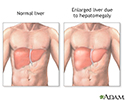Enlarged liver
Hepatosplenomegaly; Enlarged liver; Liver enlargement
Enlarged liver refers to swelling of the liver beyond its normal size. Hepatomegaly is another word to describe this problem.
If both the liver and spleen are enlarged, it is called hepatosplenomegaly.
Considerations
The lower edge of the liver normally comes just to the lower edge of the ribs on the right side. The edge of the liver is normally thin and firm. It cannot be felt with the fingertips below the edge of the ribs, except when you take a deep breath. It may be enlarged if a health care provider can feel it in this area.
Causes
The liver is involved in many of the body's functions. Its function is affected by many conditions that can cause hepatomegaly, including:
- Alcohol use (especially alcohol abuse)
- Cancer metastases (spread of cancer to the liver)
- Congestive heart failure
- Glycogen storage disease
- Hepatitis A
- Hepatitis B
- Hepatitis C
- Hepatocellular carcinoma
- Hereditary fructose intolerance
- Infectious mononucleosis
- Leukemia
- Niemann-Pick disease
- Primary biliary cholangitis
- Reye syndrome
- Sarcoidosis
- Sclerosing cholangitis
- Portal vein thrombosis
- Steatosis (fat in the liver from metabolic problems such as diabetes, obesity, and high triglycerides, also called nonalcoholic steatohepatitis, or NASH)
When to Contact a Medical Professional
This condition is most often detected by a provider. You may not be aware of the liver or spleen swelling.
What to Expect at Your Office Visit
The provider will examine you and ask questions such as:
- Did you notice fullness or a lump in the abdomen?
- What other symptoms do you have?
- Is there any abdominal pain?
- Is there any yellowing of the skin (jaundice)?
- Is there any vomiting?
- Is there any unusual-colored or pale-colored stools?
- Has your urine appeared to be darker than usual (brownish)?
- Have you had a fever?
- What medicines are you taking including over-the-counter and herbal medicines?
- How much alcohol do you drink?
Tests to determine the cause of hepatomegaly vary, depending on the suspected cause, but may include:
- Abdominal x-ray
- Abdominal ultrasound (may be done to confirm the condition if the provider thinks your liver feels enlarged during a physical exam)
- CT scan of the abdomen
- Liver function tests, including blood clotting tests
- MRI scan of the abdomen
References
Martin P. Approach to the patient with liver disease. In: Goldman L, Schafer AI, eds. Goldman-Cecil Medicine. 26th ed. Philadelphia, PA: Elsevier; 2020:chap 137.
Plevris J, Parks R. The gastrointestinal system. In: Dover AR, Innes JA , Fairhurst K, eds. Macleod's Clinical Examination. 15th ed. Philadelphia, PA: Elsevier; 2024:chap 6.
Squires JE, Balistreri WF. Manifestations of liver disease. In: Kliegman RM, St. Geme JW, Blum NJ, Shah SS, Tasker RC, Wilson KM, eds. Nelson Textbook of Pediatrics. 21st ed. Philadelphia, PA: Elsevier; 2020:chap 382.
Fatty liver - CT scan - illustration
Fatty liver - CT scan
illustration
Liver with disproportional fattening - CT scan - illustration
Liver with disproportional fattening - CT scan
illustration
Hepatomegaly - illustration
Hepatomegaly
illustration
Review Date: 5/2/2023
Reviewed By: Michael M. Phillips, MD, Emeritus Professor of Medicine, The George Washington University School of Medicine, Washington, DC. Also reviewed by David C. Dugdale, MD, Medical Director, Brenda Conaway, Editorial Director, and the A.D.A.M. Editorial team.

















